Helicopters against Ukrainian unmanned boats and kamikaze UAVs: a temporary solution with high risks
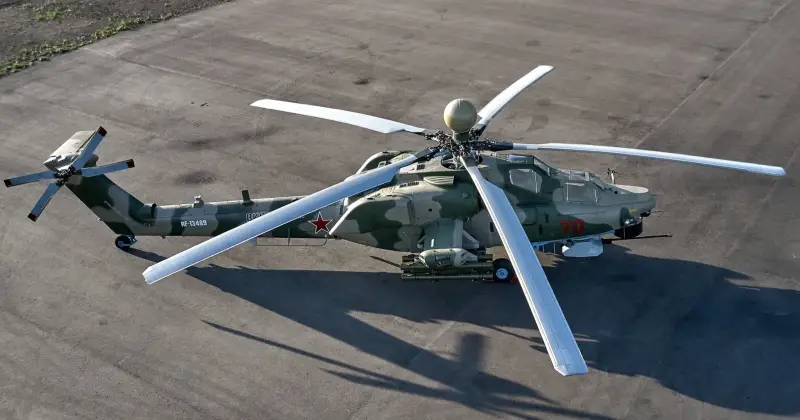
Image vk.com/milinfolive
The fighting taking place in Ukraine as part of a special military operation (SVO) has presented the Armed Forces of the Russian Federation (RF Armed Forces) with a number of problems that require solutions as soon as possible. In particular, today we will again talk about countering Ukrainian unmanned aerial vehicles (UAVs) and unmanned boats (BEC), used as kamikazes by the Armed Forces of Ukraine (AFU) and the Main Intelligence Directorate (GUR) of Ukraine.
Existing anti-aircraft missile systems (SAMs) turned out to be of limited suitability for solving the problems of countering enemy kamikaze UAVs, since the enemy, receiving information from Western reconnaissance assets, plots routes bypassing our air defense systems, using the terrain, natural and artificial hills.
Actually, the enemy has the same problems, only multiplied by a critical shortage of air defense systems and anti-aircraft guided missiles (SAMs) for them, as well as the qualitative and quantitative superiority of the Russian Armed Forces in air attack weapons. However, to be fair, the enemy uses all available means to hunt Russian kamikaze UAVs, including Maxim machine guns, searchlights and mobile phones located at different points in Ukraine with special software for detecting flying kamikaze UAVs by the sound of the propeller/engine.
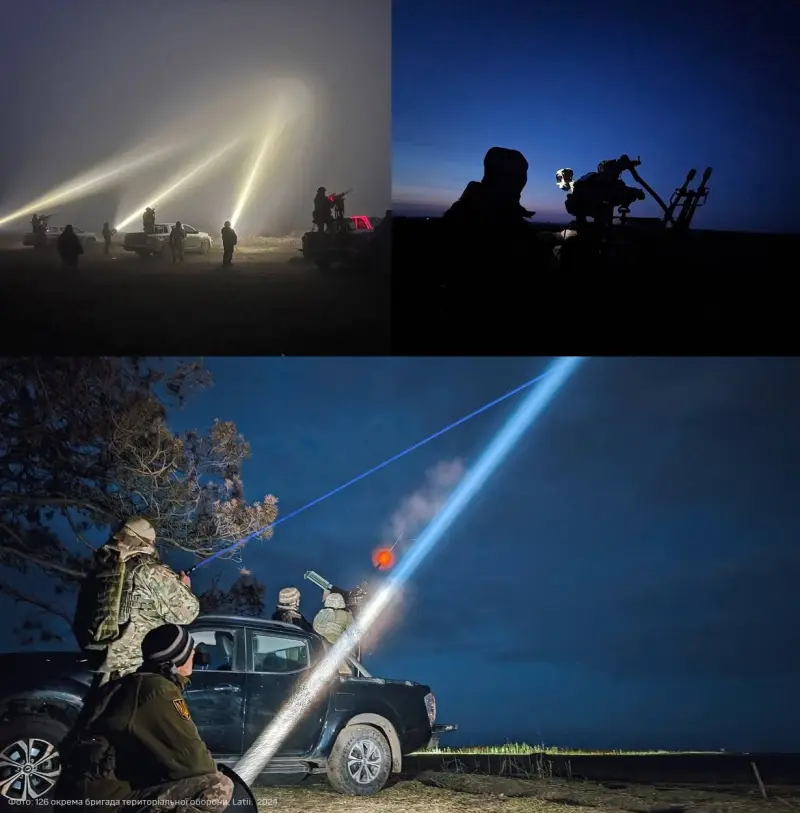
Mobile anti-drone patrols of the Ukrainian Armed Forces. Image of the Telegram channel “Military Informant”
Nevertheless, the measures taken do not provide the enemy with protection from Russian kamikaze UAVs; the problem is that long-range Ukrainian kamikaze UAVs periodically reach their targets. With the BEC-kamikaze, the situation is apparently even worse.
Simultaneously Yemen's Houthis attack civilian and military vessels in the Yemen Gulf and Red Sea using similar kamikaze UAVs, and to a limited extent, using BEC kamikazes. At the same time, judging by information disseminated by foreign resources, the naval forces of the United States and its allies use helicopters to destroy kamikaze UAVs and BEC kamikazes, and the effectiveness of using helicopters to solve these problems turned out to be quite high. Accordingly, the question of using Russian Armed Forces helicopters in a similar way is periodically raised - to counter Ukrainian kamikaze UAVs and kamikaze BECs.
This decision has the right to life, however, the use of helicopters to destroy kamikaze UAVs and kamikaze UAVs has not only advantages and disadvantages, but also carries certain risks.
Advantages
Why not use multirole fighters for this purpose?
Despite the fact that combat aircraft such as a fighter-bomber or multirole fighter are quite capable of fighting kamikaze UAVs and kamikaze BECs, their use for solving these problems is hardly advisable.
Firstly, patrolling will waste the precious resource of expensive high-tech combat vehicles, which can be used to solve other, much more important tasks.
Secondly, an hour of flight for a modern fighter is expensive, as are the guided weapons that a fighter can use against kamikaze UAVs and kamikaze BECs.
Thirdly, if you use unguided weapons, for example, a cannon, then there is a risk of losing the aircraft, both from a collision with a surface, buildings or structures when flying at low altitude, and from the debris of a downed kamikaze UAV, which the Ukrainian armed forces were able to do see from your own experience, having lost a MiG-29 fighter during an attack by a Russian UAV.
In this sense, the use of helicopters to destroy kamikaze UAVs and kamikaze UAVs looks like a much more reasonable solution. The cost of both the combat helicopter itself and its flight hour is several times lower than that of a fighter.
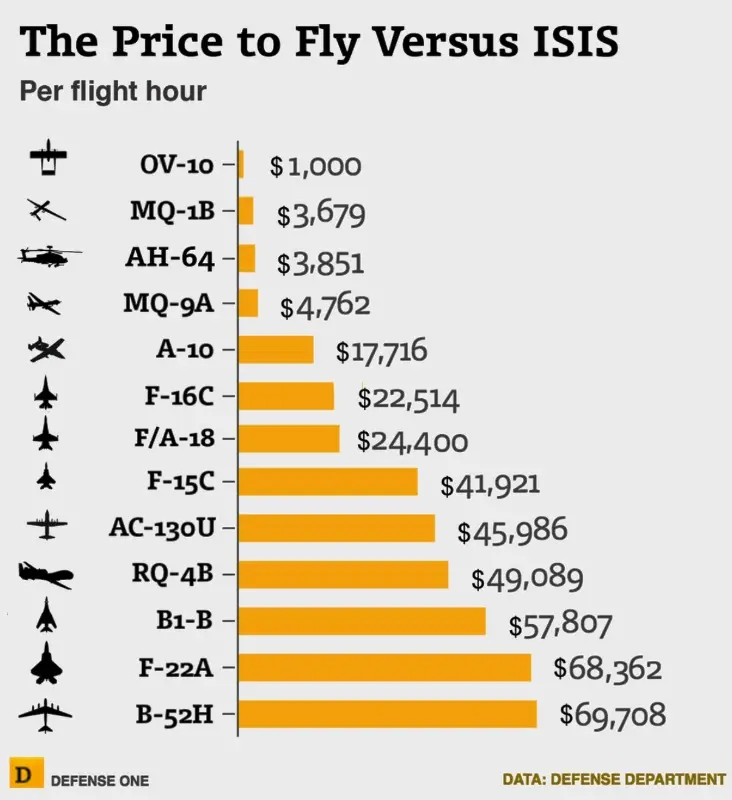
Cost of an hour of flight of various aviation funds from the US Air Force - however, some figures are questionable, for example, the cost of an hour of flight of an MQ-1B UAV seems to be overestimated, which is comparable to the cost of an hour of flight of an AH-64 combat helicopter, and the cost of an hour of flight of a B-1B supersonic bomber with variable wing geometry is less, than the much older subsonic B-52H
The helicopter's flight speed varies from zero (hovering mode) to 250–300 kilometers per hour or more, which allows you to choose the optimal speed in order to both catch up with and accompany kamikaze UAVs moving at a speed of about 150–200 kilometers per hour. The same applies to the BEC kamikaze, whose speed is even lower, up to a complete stop and a sharp change in direction of movement.
Disadvantages
The main disadvantage of most helicopters that can be used to hunt kamikaze UAVs and BEC kamikazes is the lack of an effective radar station (radar) available to air defense systems and fighters. Optical reconnaissance means alone will clearly not be enough to solve the problem of detecting kamikaze UAVs and kamikaze UAVs - with their help you can only carry out additional search, tracking and ensure the destruction of the target.
In general, technically, the Ka-52(M) and Mi-28NM combat helicopters have radars (apparently, not all Mi-28NMs), the question is how many of these machines can be allocated for hunting kamikaze UAVs and BEC kamikazes , taking into account their workload on the line of combat contact (LCC)?
In addition, the question is: what is the effectiveness of helicopter radars in terms of detecting targets such as those that are subtle in the radar wavelength range of kamikaze UAVs and kamikaze BECs?
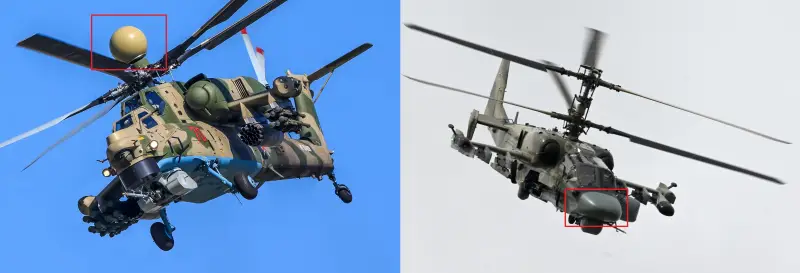
The onboard equipment of the Mi-28NM and Ka-52(M) combat helicopters includes a radar
Thus, we can say with a high degree of confidence that combat helicopters will be effective in countering kamikaze UAVs and kamikaze UAVs, provided that they are given external target designation, for example, with A-50U long-range radar detection and control aircraft (AWACS) or Tu-214R reconnaissance aircraft. The ability for helicopters to independently search for kamikaze UAVs and kamikaze UAVs will depend on the availability and effectiveness of their own radar.
The problem is that if the Russian Armed Forces can still find helicopters for hunting kamikaze UAVs and BEC-kamikazes, then with AWACS aircraft, as well as Tu-214R reconnaissance aircraft, everything is much worse for us. It can be assumed that the effectiveness of helicopters of the United States and its allies operating against kamikaze UAVs and BEC kamikazes launched by the Yemeni Houthis is largely due to the provision of primary target designation to them from surface ships and AWACS aircraft concentrated in the region.
It is also necessary to understand that the use of helicopters to destroy kamikaze UAVs and kamikaze UAVs carries quite serious risks of losing these vehicles.
Risks
At first glance, neither kamikaze UAVs nor kamikaze BECs are currently capable of causing any damage to helicopters, unless the helicopter itself flies into the kamikaze UAV or its debris. Of course, non-combat losses due to equipment failures due to intensive operation or piloting errors cannot be ruled out, but there are other risks.
In particular, when hunting kamikaze UAVs in the range of Russian air defense systems, there may be cases of “friendly fire”. Also, when operating at low altitude above land, there is a possibility of helicopters colliding with buildings and structures, for example, with power lines.
In principle, the risks of “friendly fire” can be minimized by creating a dedicated zone - a strip within which only combat helicopters hunting kamikaze UAVs will operate, and air defense systems will either be completely absent or their firing sectors will be limited.
With BEC-kamikazes everything is somewhat more complicated - at present they are also not capable of causing damage to helicopters - even crashing into a BEC-kamikaze will be quite difficult, in fact, the only risk present is the possibility of “friendly fire”, which can be minimized or eliminated in the same way, as in the case of kamikaze UAVs - the creation of dedicated zones for the actions of helicopter hunters on BEC kamikazes.
However, the enemy is making significant efforts to improve this type of weapons, including equipping BEC-kamikazes with various weapon modules. There is unconfirmed information that Ukrainian specialists have already installed units of unguided aircraft missiles (UAR) on the BEC-kamikaze; it has been announced that a module with a small-caliber, rapid-fire automatic cannon will soon be integrated into the BEC-kamikaze.
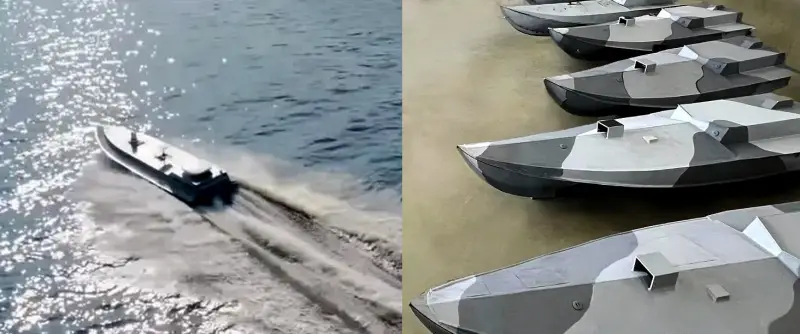
Ukrainian BEC-kamikaze Sea Baby, according to the developers, it will have a range of up to 1 kilometers, in addition to an explosive charge, it will carry a turret with a small-caliber rapid-fire automatic cannon
There is no doubt that in the near future, guided weapons will also be integrated into Ukrainian BEC-kamikazes, for example, the Sguna-P anti-tank guided missile system (ATGM) or man-portable air defense systems (MANPADS). Given the fact that ATGMs are even installed on UAVs, there are no serious technical obstacles to installing them on the BEC kamikaze.
Where it leads?
Moreover, combat helicopters searching and destroying BEC-kamikazes can turn from a hunter into a target. If you can still try from MANPADS protect combat helicopters with onboard self-defense systems, for example, of the “Vitebsk” type, especially since many MANPADS missiles cannot be supplied to BEC-kamikazes, then there are no means of self-defense against ATGMs yet, except for high flight speed, as well as against high-speed automatic guns. And Vitebsk-type complexes provide far from 100% protection against MANPADS.
What are our alternatives?
Optimal solution
Previously in materials “Waiting for the Helios-RLD UAV: for protection against low-flying air attack weapons” и “UAV “Sirius-Air Defense”: hunter of air attack weapons” The author considered promising elements of our country's deep-in-depth air defense, capable of highly effectively detecting and intercepting kamikaze UAVs in a designated area. The specified combination of UAV-AWACS and UAV-interceptor is capable of effectively fighting against BEC-kamikazes.
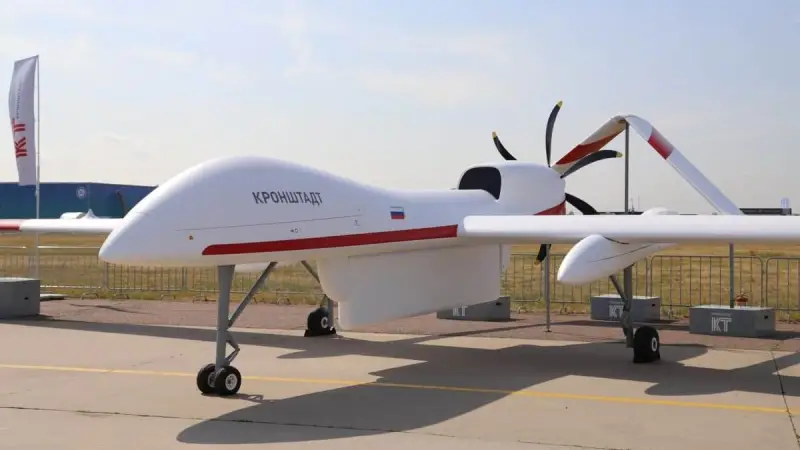
UAV "Helios-RLD"
The problem is that both the Helios-RLD UAV and the Sirius UAV are currently at the development stage, the exact timing of their entry into service is unknown, but this is unlikely to happen earlier than in a few years, while the detection and the destruction of kamikaze UAVs and kamikaze BECs must be ensured now.
The only mid-size UAV currently mass-produced in Russia is the Orion UAV. Presumably, the Orion UAV can also be quite effective as a hunter of kamikaze UAVs and BEC kamikazes, provided that primary target designation is given to it. Its disadvantages include a small payload, in addition, data on flight speed varies - from 120 to 180 kilometers per hour; at the lower limit, interception of a kamikaze UAV by Orion will be possible only on a collision course.
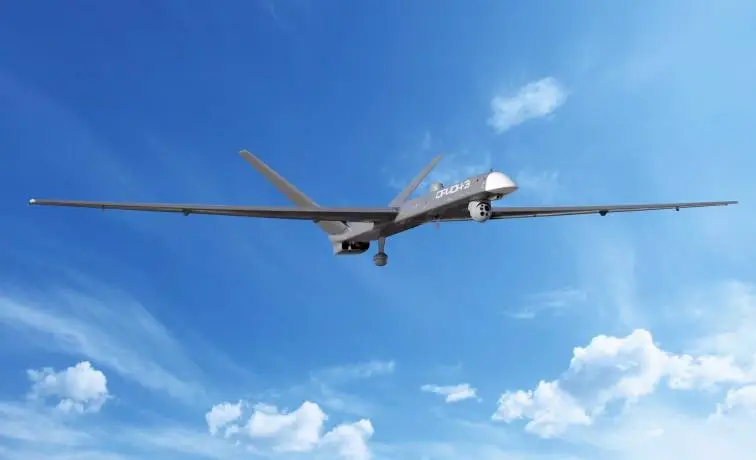
UAV "Orion". Image of the Kronstadt group
There are also helicopter-type UAVs in Russia, hybrid UAVs are being developed that are capable of performing vertical takeoff and then switching to airplane mode. It is possible that the optimal solution will be found somewhere in this direction, but this is a matter for future years.
Conclusions
Combat helicopters can be used to search and destroy kamikaze UAVs and kamikaze UAVs, taking into account a number of limitations, current and future risks.
From the point of view of detecting kamikaze UAVs and BEC kamikazes, the presence of target detection and tracking radars on helicopters is important, in terms of hunting BEC kamikazes, for protection against MANPADS, it is advisable to have onboard self-defense systems.
The use of combat helicopters to search and destroy BEC kamikazes with modules with small-caliber rapid-fire automatic guns and/or ATGMs integrated into their design can become too risky and lead to unjustified losses. It is possible that from now on it is better to use faster aircraft, for example, Su-25SM attack aircraft, to search and destroy BEC kamikazes. To increase the efficiency of their operation, they can be equipped with radar and/or electronic reconnaissance (RTR) equipment in a container design.
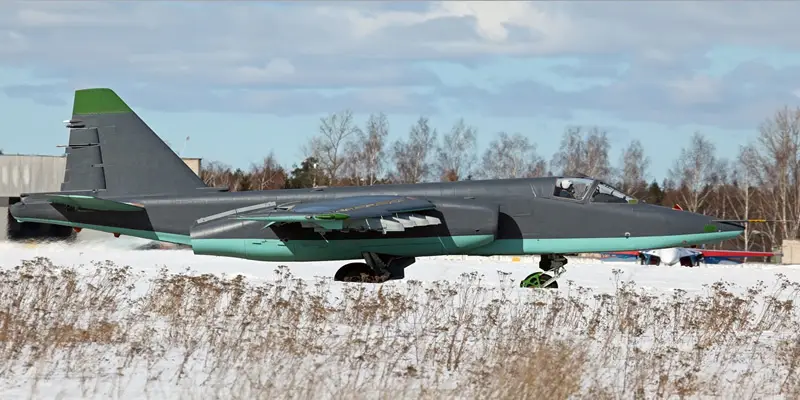
Su-25SM attack aircraft. Image: Vladimir Yazynin, Evgeny Volkov and Alexander Martynov (russianplanes.net)
However, the use of both combat helicopters and attack aircraft to search and destroy kamikaze UAVs and kamikaze BECs is a temporary measure, both from the point of view of the effectiveness and risk of losses of these combat vehicles, and from the point of view of the cost of operation.
Presumably, the most optimal option would be to use the Sirius UAV and the Helios-RLD UAV to solve these problems, while the Helios-RLD UAV should be used for the initial detection of kamikaze and BEC kamikaze UAVs, with subsequent issuance of target designation on them UAV "Sirius".
Until the development of the Sirius UAV and the Helios-RLD UAV is completed and mass production has begun, the serially produced Orion UAV can become an effective means for hunting BEC kamikazes. However, not having their own radar, they must receive primary target designation from AWACS aircraft or reconnaissance aircraft such as Tu-204R, but, as we said above, we apparently have serious problems with these aircraft, so the problem of primary detection BEC kamikaze and low-flying kamikaze UAVs remain open for now.
It is important not to miss the moment when the enemy’s BEC kamikazes begin to be equipped with weapons that can be used against our helicopters in order to avoid unjustified losses of equipment and personnel.
Information